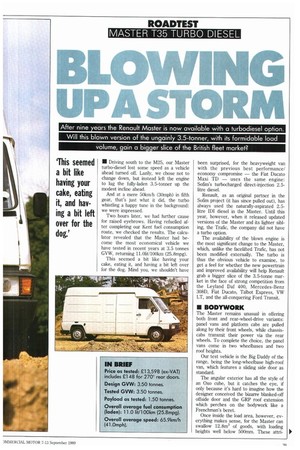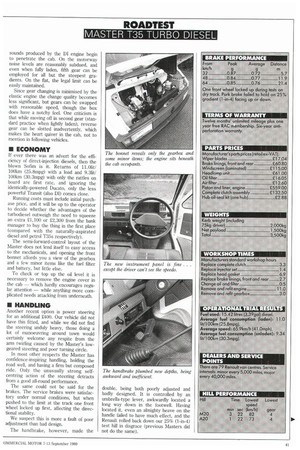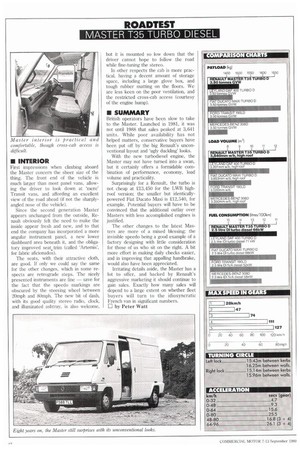BLOWING
Page 41

Page 42

Page 43

Page 44

If you've noticed an error in this article please click here to report it so we can fix it.
!.PA STORM
After nine years the Renault Master is now available with a turbodiesel option.
Will this blown version of the ungainly 3.5-tonner, with its formidable load volume, •ain a bi••er slice of the British fleet market?
• Driving south to the M25, our Master turbo-diesel lost some speed as a vehicle ahead turned off. Lazily, we chose not to change down, but instead left the engine to lug the fully-laden 3.5-tonner up the modest incline ahead.
And at a mere 50km/h (30mph) in fifth gear, that's just what it did, the turbo whistling a happy tune in the background: we were impressed.
Two hours later, we had further cause for raised eyebrows. Having refuelled after completing our Kent fuel consumption route, we checked the results. The calculator revealed that the Master had become the most economical vehicle we have tested in recent years at 3.5 tonnes GVW, returning 11.01it/100km (25. 8mpg).
This seemed a bit like having your cake, eating it, and having a bit left over for the dog. Mind you, we shouldn't have been surprised, for the heavyweight van with the previous best performance/ economy compromise — the Fiat Ducato Maxi TD — uses the same engine: Sofim's turbocharged direct-injection 2,5litre diesel.
Renault, as an original partner in the Sofim project (it has since pulled out), has always used the naturally-aspirated 2.5litre IDI diesel in the Master. Until this year, however, when it released updated versions of the Master and its lighter sibling, the Trafic, the company did not have a turbo option.
The availability of the blown engine is the most significant change to the Master, which, unlike the facelifted Trafic, has not been modified externally. The turbo is thus the obvious vehicle to examine, to get a feel for whether the new powertrain and improved availability will help Renault grab a bigger slice of the 3.5-tonne market in the face of strong competition from the Leyland Daf 400, Mercedes-Benz 308D, Fiat Ducato, Talbot Express, VW LT, and the all-conquering Ford Transit.
• BODYWORK
The Master remains unusual in offering both front and rear-wheel-drive variants: panel vans and platform cabs are pulled along by their front wheels, while chassiscabs transmit their power via the rear wheels. To complete the choice, the panel vans come in two wheelbases and two roof heights.
Our test vehicle is the Big Daddy of the range, being the long-wheelbase high-roof van, which features a sliding side door as standard.
The angular exterior has all the style of an Oxo cube, but it catches the eye, if only because it's hard to imagine how the designer conceived the bizarre blanked-off offside door and the GRP roof extension which perches on the bodywork like a Frenchman's beret.
Once inside the load area, however, everything makes sense, for the Master can swallow 12.8m3 of goods, with loading heights well below 500mm. These attri
butes, which undoubtedly account for the Master's popularity with replacement window companies and the like, are a direct result of its FWD design.
The use of single rear wheels (unlike the opposition from Leyland Daf and Ford) maximises the usable width of the load bed, though the space taken by stowing the spare wheel inside, and the shortage of decent tie-down points, detract from its practicality.
The twin rear doors provoked mixed feelings. On the positive side, they almost reach the top of the bodywork and provide unobstructed access to the vast space within.
Our vehicle also sported sturdy-looking 270° hinges (a £148 option), allowing the doors to be clipped neatly to the side of the vehicle.
On the negative side, the doors rattled like a ball-bearing in a tin, however carefully they were closed; they also defied all attempts to open them from the outside once locked shut.
The size of the body and the weight of the diesel engine reduces the maximum payload to a modest 1,500kg (200kg less than the equivalent petrol 135). Both the Transit and the Sevel vans have appreciably lower unladen weights.
• DRIVELI NE
The move to turbodiesel propulsion for 3.5 tonners has gathered pace in the past year, with Leyland Daf, Ford (in limited quantities only) and now Renault satisfying operators' lust for more power.
The Master benefits from the latest 2,499cc variant of the Sofim DI diesel, which is used by Iveco Ford in the second generation TurboDaily. Installed in the Renault, the iron block/alloy head overhead-camshaft engine is rated at 66kW (88hp) at 3,800rpm and 200Nm (148Ibft) at 2,200rpm, representing 15% more power and 20% more torque than the latest naturally-aspirated diesel.
As a result of the greater output, the turbo gains higher ratios for its five-speed gearbox, a larger 235mm diameter clutch, and beefier driveshafts.
• PERFORMANCE
As described in the introduction to this test, the Italian-built engine produces useful power from tickover, and its smoothness and flexibility makes the driver's job an easy one. By changing up early swift progress can be maintained, but not at the expense of refinement or economy.
Hanging on to the lower gears serves no purpose, for at higher revs the harsher sounds produced by the DI engine begin to penetrate the cab. On the motorway noise levels are reasonably subdued, and even when fully laden, fifth gear can be employed for all but the steepest gradients. On the flat, the legal limit can be easily maintained.
Since gear changing is minimised by the elastic engine the change quality becomes less significant, but gears can be swapped with reasonable speed, though the box does have a notchy feel. One criticism is that while moving off in second gear (standard practice when lightly laden), reverse gear can be slotted inadvertently, which makes the heart quiver in the cab, not to mention in following vehicles.
• ECONOMY
If ever there was an advert for the efficiency of direct-injection diesels, then the blown Sofim is it. Returns of 11.01it/ 100km (25.8mpg) with a load and 9.31it/ 100km (30.3mpg) with only the rattles on board are first rate, and ignoring the identically-powered Ducat°, only the less powerful Transit (also DI) comes close.
Running costs must include initial purchase price, and it will be up to the operator to decide whether the advantages of the turbodiesel outweigh the need to squeeze an extra £1,100 or £2,300 from the bank manager to buy the thing in the first place (compared with the naturally-aspirated diesel and petrol T35s respectively).
The semi-forward-control layout of the Master does not lend itself to easy access to the mechanicals, and opening the front bonnet affords you a view of the gearbox and a few minor items like the fuel filter and battery, but little else.
To check or top up the oil level it is necessary to remove the engine cover in the cab which hardly encourages regular attention while anything more complicated needs attacking from underneath.
• HANDLING
Another recent option is power steering for an additional £400. Our vehicle did not have this fitted, and while we did not find the steering unduly heavy, those doing a lot of manoeuvring around town would certainly welcome any respite from the arm twirling caused by the Master's lowgeared steering and poor turning circle.
In most other respects the Master has confidence-inspiring handling, holding the road well, and having a firm but composed ride. Only the unusually strong selfcentring action of the steering detracts from a good all-round performance.
The same could not be said for the brakes. The service brakes were satisfactory under normal conditions, but when pushed to the limit at the track one front wheel locked up first, affecting the directional stability.
We suspect this is more a fault of poor adjustment than bad design.
The handbrake, however, made the double, being both poorly adjusted and badly designed. It is controlled by an umbrella-type lever, awkwardly located a long way down in the footwell. Having located it, even an almighty heave on the handle failed to have much effect, and the Renault rolled back down our 25% (1-in-4) test hill in disgrace (previous Masters did not do the same).
• INTERIOR
First impressions when climbing aboard the Master concern the sheer size of the thing. The front end of the vehicle is much larger than most panel vans, allowing the driver to look down at 'mere' Transit vans, and affording an excellent view of the road ahead (if not the sharplyangled nose of the vehicle).
Since the second generation Master appears unchanged from the outside, Renault obviously felt the need to make the inside appear fresh and new, and to that end the company has incorporated a more angular instrument panel, a new lower dashboard area beneath it, and the obligatory improved seat trim (called 'Artemis', for fabric aficionados).
The seats, with their attractive cloth, are good. If only we could say the same for the other changes, which in some respects are retrograde steps. The nicely presented instruments are fine — save for the fact that the speedo markings are obscured by the steering wheel between 20mph and 80mph. The new bit of dash, with its good quality stereo radio, clock, and illuminated ashtray, is also welcome, but it is mounted so low down that the driver cannot hope to follow the road while fine-tuning the stereo.
In other respects the cab is more practical, having a decent amount of storage space, including a large glove box, and tough rubber matting on the floors. We are less keen on the poor ventilation, and the restricted cross-cab access (courtesy of the engine hump).
• SUMMARY
British operators have been slow to take to the Master. Launched in 1981, it was not until 1988 that sales peaked at 3,641 units. While poor availability has not helped matters, conservative buyers have been put off by the big Renault's unconventional layout and 'ugly duckling' looks.
With the new turbodiesel engine, the Master may not have turned into a swan, but it certainly offers a formidable combination of performance, economy, load volume and practicality.
Surprisingly for a Renault, the turbo is not cheap at £13,450 for the LWB highroof version; the smaller but identicallypowered Fiat Ducato Maxi is £12,540, for example. Potential buyers will have to be convinced that the additional outlay over Masters with less accomplished engines is justified.
The other changes to the latest Masters are more of a mixed blessing; the invisible speedo being a good example of a factory designing with little consideration for those of us who sit on the right. A bit more effort in making daily checks easier, and in improving that appalling handbrake, would also have been appreciated.
Irritating details aside, the Master has a lot to offer, and backed by Renault's aggressive marketing it should continue to gain sales. Exactly how many sales will depend to a large extent on whether fleet buyers will turn to the idiosyncratic French van in significant numbers.
by Peter Watt




















































































































